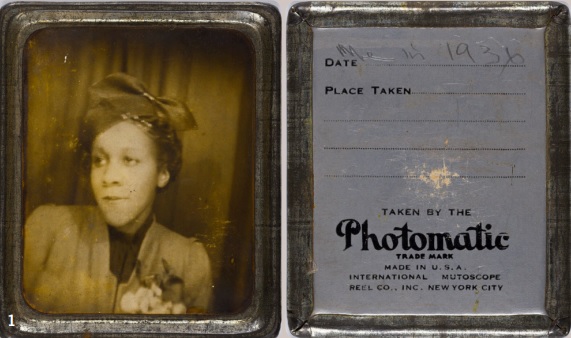Editor’s Note: A version of this article first appeared in Broadside, the magazine of the Library of Virginia, Issue No. 4, 2020.
Squeezing into a cramped photo booth with the curtain pulled, changing facial expressions as the camera clicked off, and anxiously waiting for the vertical photo strip to appear was a familiar routine for generations of Americans. With no photographer to coax them into position or command them to smile, people were at liberty to appear however they wanted, making these portraits the “selfies” of their day. The resulting images of individuals, pairs, or even small groups are occasionally flirtatious, sometimes goofy, and always mesmerizing.
Examples of these early spontaneous souvenir portraits appear in many family photograph collections and albums in the Library’s Visual Studies Collection. Although we know very little about the people who made them or the circumstances that inspired their creation, these images tempt us to imagine the lives of their makers—and they show us what it was like to have a little fun.
Russian immigrant Anatol Josepho first conceived of a design for the machine in the 1920s: a small, curtain-enclosed booth where people could take affordable portraits anonymously and automatically. For the cost of a few coins dropped into a slot, his invention would photograph the sitter, develop the images, dry them, and deliver the prints in under 10 minutes. Josepho’s “Photomaton,” located in New York City, attracted enormous crowds who waited in long lines to pay 25 cents for their turn behind the curtain. The device was an immediate success, and Josepho’s efforts were rewarded in 1927 when a group of businessmen purchased the patent for a million dollars.
The economic impact of the Great Depression during the 1930s forced many Americans to curtail their leisure activities, yet the photo booth’s popularity did not seem to diminish. People managed to find a dime or quarter to take what, for some, was probably the only photograph they could afford. The booths appeared in train and bus stations, penny arcades, and drugstores across the country. Some clever entrepreneurs who could not afford to purchase a photo booth built their own makeshift versions. A photographer hidden in the back would shoot and develop the pictures and carefully slip them through a slot to the unsuspecting sitters.
The audience for these portraits grew exponentially during the 1940s, when an estimated 30,000 photo booths could be found in the United States alone. By midcentury, they had become a recognizable symbol of pop culture. John and Jackie Kennedy playfully climbed into a photo booth in the 1950s, and Fred Astaire had his photo taken in one within a dance sequence in the 1953 film The Band Wagon. In the 1960s, Andy Warhol famously shuttled models from photo booth to photo booth in Times Square to acquire portraits to use in his artwork, and John Lennon and Yoko Ono included a reproduction of a photo-booth strip in the box set of their 1969 Wedding Album record.
Unfortunately, the advent of Polaroid photography and the increased demand for instant cameras slowly forced many photo booths out of business during the 1970s and 1980s. Digital photography sparked a photo-booth comeback with rentals for parties and weddings in the 1990s, but by that point, the original old-fashioned photo booths were nearly extinct. Only a few hundred authentic chemical photo booths are still in use today. With the arrival of smartphone cameras and social media platforms, self-portraits have become ubiquitous, but many lack the lightheartedness that can be found in 20th-century photo booth images.
— Dale Neighbors, Visual Studies Collection Coordinator












